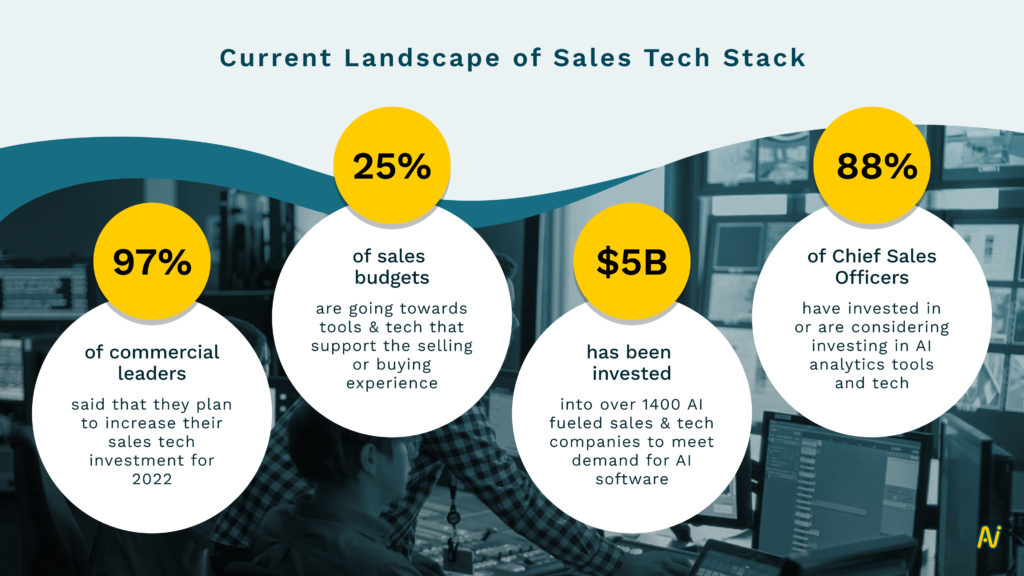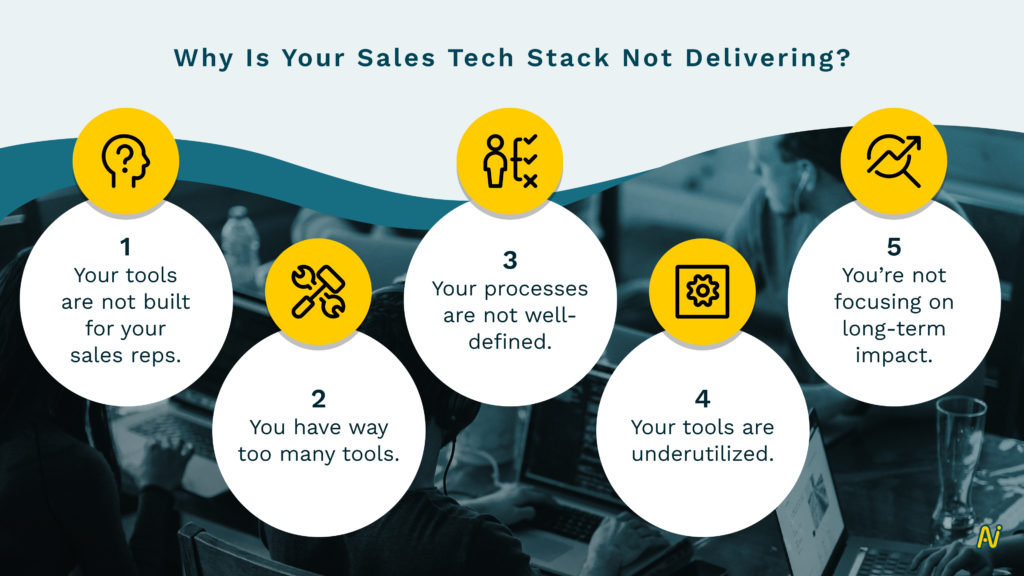Deriving maximum value from their sales tech stack investments continues to be a frustrating challenge for revenue leaders.
With more than 1200 sales tools in the market spread over 49 categories, how do you select the right tools that can help you drive your revenue strategy?
Well, the answer to this question is not a straight-forward one.
Before we get deeper to explore nuances of this question, let’s first understand what a sales tech stack is.
What is a Sales Tech Stack?
A sales tech stack is a set of software tools and technologies that help optimize the performance of your sales teams.
The kind of sales tech stack you choose to invest in can have a significant impact on your revenue engine.
A thoughtfully selected and implemented sales tech stack helps remove bottlenecks from the sales process. By closing the existing gaps, it ultimately helps your reps close more deals.
Current Landscape of Sales Tech Stack
The current landscape of the sales tech market, as Gartner puts is, is absolute mayhem.
The pandemic forced sellers to move to virtual selling.
Buyers quickly adapted to this new reality. 50% of buyers say that working remotely has made the purchasing process easier.
These rapid changes increased the need for technology that can enable sellers to meet the rising demands of the modern buyer.
Capturing leads, reaching out to prospects, engaging or communication – all these facets of sales are harder than ever before.
The right sales tech stack can help sellers optimize the buyer’s journey and thrive in today’s hyper-competitive sales environment.
Let’s look at some of the top trends in the sales tech landscape as of 2022:
1. Narrow list of vendors offering multiple capabilities
The biggest trend that was seen in 2021 was vendor consolidation, where large companies were seen evolving their tech stacks to more categories than ever.
The market is fast moving towards a narrow list of vendors that offer a wide portfolio of capabilities. For example, HubSpot emerged as a top player in a total of 7 categories including CRM.
Another example is ZoomInfo’s acquisition of Chorus.ai where a large data provider is now offering conversation intelligence features.
2. CRM continues to emerge as a mature category
Well-established companies continue to dominate the CRM space, making this a more mature category in sales tech than others. Most CRMs also offer complimentary sales tools.
For example, HubSpot continues to be a leader in the CRM space, and also offers complimentary sales tools such as email tracking and marketing automation.
3. Increase in sales budgets for sales tech investment
97% of commercial leaders plan to increase their sales tech investment for 2022.
And 25% of sales budgets are going towards tools and technologies that support the selling or buying experience.
The investment in sales tech is increasing and it looks like it’s only going to increase in times to come.
4. There has been a rise in investment into AI and ML technology in sales tech
AI fuelled sales and technology companies have seen more than $5 Billion in investment in 2021.
88% of Chief Sales Officers (CSOs) have already invested in or are considering investing in AI analytics tools and technologies.
Companies that adopt and build on this new technology can have a competitive advantage in their respective market.

Why Is Your Sales Tech Stack Not Delivering?
There is clearly not a dearth of sales tools that companies use.
67% of sales teams use between 4 and 10 digital selling tools as part of their sales tech stacks.
But 42% of sales teams fail to see a clear ROI on these tools.
The real question then is not how many tools sales teams are using. But how effective are these tools in making sales teams win more deals?
Let’s look at some of the top reasons why your sales tech stack is not delivering.
1. Your tools are not built for your sales reps
Most conventional sales tools are not built for sales reps. They are geared towards the sales managers and sales ops leaders.
These tools help to audit the sales reps, but do nothing to help them close more deals or make them productive.
Using these tools also lead to time wastage as sales reps have to jump multiple hoops to get their job done, be it entering data into a CRM (17% of daily time), collaborating with their peers or other functions.
If your sales tools are making your reps’ lives harder and not helping them sell better, it’s clear why it is not delivering value.
2. You have way too many tools
According to SBI’s research, an organization purchases 27 sales tools on an average. And the average number of planned tool purchases stand at 4.
This research suggests that organizations’ tool purchases are spontaneous. Most decisions to invest in sales tools might not align with the company’s long-term growth strategy.
Because of a lack of thoughtful evaluation, most tools end up being redundant, unused or simply useless.
3. Your processes are not well-defined
Most processes around the purchase and implementation of sales tech are not clearly defined.
60.67% of organizations say that they have a somewhat structured purchase process for sales tools. And only 43.82% of organizations have a clearly defined implementation process.
Having no central stakeholder to create a roadmap for the purchase, implementation and continuous reinforcement of the right processes increases the risk of a lower ROI from sales tech investment.
4. Your tools are underutilized
Companies utilize less than 50% of the potential of the sales tools that they buy.
Even tools that are critical for day-to-day operations have a low degree of usage.
For example, 74% of respondents in a survey said that Account and Opportunity Management is a critical tool for their day-to-day operations. However, only 45% of companies actually end up utilizing this tool.
The inability to leverage tools to their full capacity might be because companies aren’t enabling their reps to use the tool effectively. Or are failing to administer the solution in a way that its full value is realized.
It could also be that the tools are very complicated or the training and enablement is not taking place.
5. You’re not focusing on long-term impact
SBI research suggests that most sales tech investment decisions are made around “catch up” tools or approving one-off manager requests for new capabilities.
This short-sighted approach eliminates the scope of getting value out of sales tech investments in the long run.
Failure to base tech investment on a roadmap that looks into the future prevents revenue teams from laying down a successful sales strategy.

How Can You Make Your Sales Tech Stack Deliver?
Adding the right tools to your sales tech stack requires a detailed evaluation. It’s not something that you can do overnight.
Here are a few things you must do before you make any investment.
1. Identify the challenges in your sales process
No two companies operate in the same sales environment. Then why would their sales tech stack requirements be the same?
The first step to choosing tools in your sales tech stack would be to understand your own sales process.
Which stage of your sales process comes with the maximum challenges?
Which stages do your sales reps struggle the most with?
For example:
- Your reps might be facing the maximum challenge during the closing stage. For this, you will need a tool that gives you better deal visibility at every stage of the sales process to help you understand what needs to change in the initial stages.
- You reps might need some help prioritizing how they spend their time, focusing on more selling activities. For this you might want to invest in a tool that automatically captures CRM data and maintains CRM data hygiene.
- Your reps might be missing out on deals by failing to engage with all stakeholders in a buying group. For this, you might want to invest in a sales tool that helps your sales reps multithread with your buying committee.
Take a step back and analyze these gaps in your sales process. Once you know your top pain points across each stage of the sales process, you can prioritize and phase the introduction of new sales tools.
2. Audit your current sales tech stack
Once you have figured out your unique challenges in your sales process, take some time to audit your current tools and whether or not they help you close the gaps you just laid out.
What are the tools that your reps aren’t using?
What’s the reason for this?
Is the tool not delivering value or do the reps need to be enabled to use the tool effectively?
Instead of adding more technology to an already towering stack, start by eliminating tools that your reps aren’t using.
And for tools that are useful but not delivering value, see how you can fit in enablement to make them work for your reps.
Do this analysis to consolidate a list of tools that your reps will use. And then move on to see if you need more tools to add on the basis of the gaps you might still need to fill.
3. Get the buy-in of your sales reps
Make sure the tools you choose to add to your sales tech stack are designed for your sales reps.
They are the end users. It is critical to get their feedback on the impact of tech on their regular selling activities.
IT or sales leadership choosing tools without taking feedback from sales reps will lead to misalignment between what is adopted and what is actually useful for sales reps.
Make your reps the center of your purchase decisions and ask:
- What do your reps do on a daily basis to nurture relationships and close deals?
- What are the challenges they face in their day-to-day selling activities?
- How can a tool support your reps by eliminating their daily struggles and making them more productive?
On the basis of these answers, find tools that help remove the unique obstacles your reps face, get their approval for them and see how you can communicate its impact on their daily life to get their buy-in.
Doing this is crucial as opposed to forcing your reps to adapt to a new solution which they might not even care about.
Here is a list of 10 questions you must ask before investing in a sales tech stack.
Tools to Have in Your Sales Tech Stack
The sales tech stack you choose will be unique to your company based on your goals, challenges and the buyers you target.
In this segment, we have consolidated popular sales tech stack tools that you can explore for your business.
Let’s take a look at some examples:
– Customer Relationship Management (CRM)
A CRM serves as a single source of customer information and captures interactions with both current and potential customers.
It helps sales teams access real-time information on contact information, communication history, customer engagement etc and helps teams know where the customers are in the sales funnel, all in one place.
Some popular CRM’s for sales teams include:
HubSpot
Cambridge, Massachusetts
HubSpot Sales Hub helps sales teams supercharge their sales process with an intuitive and powerful CRM that includes several complementary tools such as sales engagement, email tracking etc.
Salesforce
San Francisco, CA
Salesforce helps businesses of all sizes accelerate sales, automate tasks and make smarter decisions through a powerful suite of tools that includes a CRM, productivity tools and intelligent data gathering.
Zoho CRM
Zoho CRM Austin, TX
Zoho CRM enables sales teams to attract, retain and delight customers through a customer-focused approach.
Active Campaign
ActiveCampaign Chicago, IL
Active Campaign helps sales teams create optimized customer experiences by automating many processes and sending personalized messages to them across channels.
– Sales Engagement
Sales engagement platforms are tools that help sellers optimize the interaction they have with their prospects and customers. These tools streamline the sales process by combining sales and marketing efforts to create customized and automated sales journeys across all potential touchpoints (email, calls, social media, video, etc.)
Sales engagement software integrates with existing sales solutions like a CRM software, email software or a sales intelligence software.
Some popular companies offering sales engagement solutions include:
SalesLoft
Atlanta, GA
SalesLoft is a sales engagement platform that helps teams set and implement a cadence of communications to convert prospects into customers. It offers features like real-time email tracking and integrated sales dialer and social communications.
Outreach
Seattle, WA
Outreach is a sales engagement platform that automates and prioritizes all customer touchpoints throughout the sales process and gives reps a single, integrated view of all prospect information. This helps reps to drive more pipeline, book more meetings and exceed revenue goals.
Groove
San Francisco, CA
Groove is a sales engagement platform that automates non-sales activities such as CRM data entry, enabling sales teams to spend more time on selling activities that generate revenue.
Groove eliminates the need for CRM data entry and provides managers with real-time visibility into activity levels and performance, regardless of location.
– Sales Coaching
Sales coaching tools help capture, analyze and provide feedback related to sales calls to continuously improve win rates and keep a track on best practices.
Coaching tools identify pivotal moments in conversations and highlight areas that need improvement.
These observations are shared with the corresponding sales person and integrated with call dialers or CRM software to pull and store the call recordings.
Some popular companies offering sales coaching solutions include:
Chorus.ai
San Francisco, CA
Chorus.ai, now acquired by ZoomInfo, is a conversation intelligence platform that helps sales teams win more deals and coach reps to become top performers.
It captures and analyzes all customer calls, meetings and emails and pinpoints areas of improvement.
AI-driven insights reveal who needs coaching and what skills need to be developed in which rep based on real customer interactions.
Mindtickle
San Francisco, CA
Mindtickle is a sales readiness platform that helps leaders and sellers to continuously assess, discover and evolve the knowledge, skills and behaviors that are required to close more deals and engage customers.
– Unified Activity Capture Solution
Unified activity capture solutions align the entire go-to-market function and aligns all revenue-driving functions like sales, marketing and customer success.
These insights help build stronger pipelines, unlock hidden coaching opportunities and help sales teams close more deals.
Unified activity capture tools can easily integrate with CRM solutions like salesforce and provide powerful insights on the data that organizations already have.
Example of companies that provide this solution:
Nektar.ai
Singapore
Nektar is an automated data capture and intelligence layer for revenue teams that assures complete CRM data integrity, where every opportunity and account gets packed with unified contact and activity data, captured from your GTM tools (email, calendar, Zoom, Slack) granting revenue leaders a true view of buyer coverage and pipeline progression so they can close revenue faster.
It automates CRM data entry, provides AI-driven insights on deal activity, helps discover depth and strength of relationship with the buying committee, executes winning playbooks and drives revenue predictability.
– Sales Performance Management
Sales performance management tools manage and record sales performance of individuals and teams on the basis of scorecards to determine success and offer guidance on how to improve sales capabilities.
Most sales performance management tools integrate with CRM software. Here are some examples companies that offer this solution:
Spiff
Sandy, UT
Spiff helps companies power their commission programs, motivate their sales teams and enable sales teams to focus on revenue generating activities instead of working on spreadsheets.
Sales managers and reps can see their commissions in real-time which makes the process clear and transparent for everyone.
– Partner Management
Partner management tools improve communication between sales teams and business partners by giving them a portal to access documents, communicate and exchange information and content between a company and its partners.
Sales teams can define access rights for each user, group, role etc., get notifications defined according to business rules and track and measure the effectiveness of MDF, co -op and co – branded partner activities.
Examples of companies that offer partner management tools are:
PartnerStack
Toronto, Canada
PartnerStack enables companies to extract the maximum value from their business partnerships by supporting affiliate, referral and reseller channel partners to drive recurring revenue.
Zinfi
Pleasanton
Zinfi’s Unified Channel Management (UCM) platform enables vendors to drive profitable growth by deploying a set of cloud-based modules for seamlessly recruiting, engaging, enabling and managing partners.
Crossbeam
Philadelphia, PA
Crossbeam is a partner ecosystem platform that helps companies build more valuable partnerships through account mapping tools, industry-leading networking and integration features.
It helps companies find overlapping customers and prospects while keeping the rest of their data private and secure.
– Sales Demo
Sales demo tools armour sales reps with all they need to deliver a great demo, be it delivering high-quality video and audio, screen sharing, recording or integrating with other scheduling tools.
Examples of companies that offer sales demo tools:
Zoom
San Jose, CA
Zoom is a popular video meeting tool that allows sales reps to meet, share their screen, record an interaction and save recordings with prospects and team members.
Walnut
New York, United States
Walnut allows sales teams to create customizable, reusable and interactive product demos through a codeless platform.
It allows reps to offer each prospect a unique experience by sending a link to a personalized demo in their emails, and also gives insights on prospects usage.
– Contract Management
Contract management tools automate the creation, tracking and monitoring of contracts, enabling multiple stakeholders to stay on top of the contracting process, participate in it and ensure compliance with laws and regulations.
This software typically integrates into existing tools like CRM software.
Some companies that offer contract management services are:
PandaDoc
San Francisco, CA
PandaDoc provides an all-in-one document workflow automation platform to help fast-moving teams to easily manage the creation, editing and signing of documents including proposals, quotes, contracts etc.
Proposify
Halifax, Canada
Proposify offers an all-in one closing tool that helps sales teams create, send, track and close proposals and other contracts.

Looking Ahead
Choosing the right sales tech stack is not easy. Nor is it a copy-and-paste effort.
It requires careful evaluation, strategic thinking and alignment with overall goals.
By choosing the template above, we hope you can make better choices for what sales tools can help your company meet its unique goals and drive more revenue.
If you have any questions on what sales tech might help you, reach out to us.








